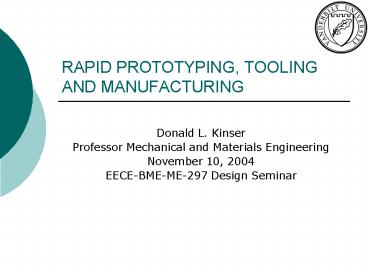RAPID PROTOTYPING, TOOLING AND MANUFACTURING
1 / 34
Title: RAPID PROTOTYPING, TOOLING AND MANUFACTURING
1
RAPID PROTOTYPING, TOOLING AND MANUFACTURING
- Donald L. Kinser
- Professor Mechanical and Materials Engineering
- November 10, 2004
- EECE-BME-ME-297 Design Seminar
2
WHAT IS RAPID PROTYPING?
- Generic Term for ALL processes which generate
prototypes quickly - Formative
- Subtractive
- Additive
- Combinations or hybrid techniques
- Google 11/2/04 rapid prototype produced 424,000
results!
3
Rapid Prototype TechniquesFormative
- Assembly of part by addition of components such
as flat, channel, angle, rod, tube or other
standard form available as a commodity - Joining may involve adhesives, welding, brazing,
soldering or mechanical fastening
4
Rapid Prototype TechniquesSubtractive
- Beginning with chunk of stock and removing
portions through cutting operation - Rapid subtractive techniques include
- Computer controlled machining
- CNC computer numeric control or
- NC numerical control
From Solid Concepts
5
Rapid Prototype TechniquesAdditive processes
- Invention of Additive Process
- Father of process Chuck Hall US Patent 1986
Photopolymer based stereo lithography (3-D
printing) - Commercialization of photopolymer based process
begin in 1987 - Rapid growth 495 million service bureau 2002
with continuing rapid growth possibly 1 billion
2004! (Wohlers Report 2002) (http//www.wohlersas
sociates.com) - Alternative processes such as lamination,
extrusion, sintering and jetting quickly
developed
6
First additive process
- Components
- Laser 26
- Platform 29
- Motion control in X, Y and Z
- Photopolymerizable liquid 23
- Partially completed part 30
- From Hull patent 4575330- 3/11/1986
7
Why Rapid Prototype?
- Functional experimental model
- Industrial design for look, feel,
- Design of experiments-LAYOUT
- Beta full scale functional with rough edges!
- Preproduction
- Tooling
- Assembly
- Verify performance
- Financier, marketing, presale samples
8
Design of experiments-LAYOUT
9
Proof of conceptFunctional experimental model
10
Preproduction
11
Prototype USE?
- Communication
- Customers, suppliers, vendors, management,
investors - Demonstration of project goals
- Scheduling demonstration of milestones
- Feasibility
- Architectural interfacingfit, form, tolerance
12
Benefits of prototypes
- Enhanced freedom and care in allocating
resourcesidentify top priority design issues - Reduction of costly iterations
- Acceleration of parallel activities
- More flexible product choices
- Pitfalls and distractions
- Delay time to market through unnecessary
prototype complexity or iteration - Failure to allocate time to integrate leads to
inability to integrate prototype results into
final product design
13
Additive prototype process 2004
- Initial step assumes the existence of a 3-D CAD
model of the part (2-D CAD design must be
converted!) - CAD model is fed to a computer program which
generates a solid model composed of triangular
elements - Solid model is then converted to layered
structure
14
Additive prototype process 2004
- Physical Problems with element generation
- Faceting
- Stair stepping
- Ovalization
15
2004 Additive Technologies
- Stereo lithography
- Selective laser sintering
- Fused deposition modeling
- 3-D printing
- On the horizon
- direct laser deposition of metals and ceramics
- Direct build of parts for sale
16
Stereolithography
- Most widely used permits creation of complex 3-D
models by successive laser curing of liquid
monomer resin
From Penn State learning factory
17
SLA Systems/Stereolithography.com
- System capabilities (100-800K)
- Beam (diameter _at_ 1/e2) Small spot 0.23 - 0.28 mm
(0.009 - 0.011 in) - Large spot 0.685 - 0.838 mm (0.027 - 0.033 in)
- Maximum part drawing speed Small spot 2.54 m/sec
(140 ips) - Large spot 9.52 m/sec (525 ips)
- Elevator
- Vertical resolution 0.001 mm (0.00004 in)
- Position repeatability 0.01 mm (0.0004 in)
- Build Volume 508 x 508 x 584 mm
- Maximum part weight 68 kg (150 lb)
- www.3dsystems.com
18
Stereo lithography Parts
Compartmentalized bowl from Stereolithography.com
19
Stereo lithography Parts
Paintball gun model from Stereolithography.com
20
Selective laser sintering
Penn State learning factory
21
Z Corp Selective laser sintering25,900 system
- Build Volume
- 8 x 10 x 8 (203 x 254 x 203 mm) Layer
Thickness - User selectable at time of printing .003-.010
(.076-.254 mm) - Z Corp Selective Laser Sintering DEMO MOVIE
22
Selective laser sintering small parts
Z Corp carburetor body
23
Selective laser sintering complex parts
Z Corp housing
24
Selective laser sintering big parts
Z Corp Electrolux trim
25
Selective laser sintering aerodynamic flow model
Z Corp wind tunnel flow model
26
Medical Applications
- Facilitating preoperative planning and rehearsal
to optimize surgical technique - Ensuring superior implant design and body fit,
reducing operative time and risk - Rapidly providing anatomically accurate skeletal
models for surgeon evaluation - Refining available diagnostic information
- Providing durable models that can be easily
transported and sterilized for intraoperative use
- Improving patient communications for informed
consent of surgical procedures
27
Selective laser sintering surgical models
Z Corp skull section for surgery planning
28
Fused deposition modeling
Penn State learning factory
29
Fused deposition technology-little stuff
- Stratasys
- Stratasys FDM build movie (sales pitch)
Stratasys connector body
Stratasys small parts 0.005 inch detail
30
Fused deposition technology-big stuff
Stratasys differential cover
31
Fused deposition technology-big stuff
Stratasys monitor housing
32
Fused deposition technology-big stuff
Stratasys motorcycle cowling
33
Rapid Prototype Tooling
- Prototyping of injection molds and dies employing
sacrifice of prototype model pattern - Sand casting
- Investment casting
- Injection molding
34
Recent developments
- Direct Manufacturing from Digital Parts Catalog
- Laser deposition of metal or ceramic to fabricate
final product - Other techniques to generate salable parts
- Portable parts manufacturing strategies under
consideration by NASA with US Army experimental
deployment of parts factory

